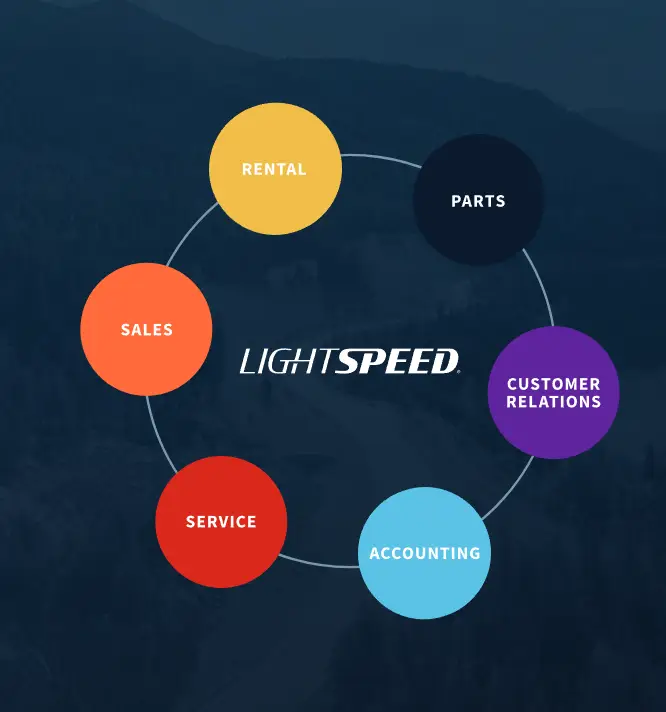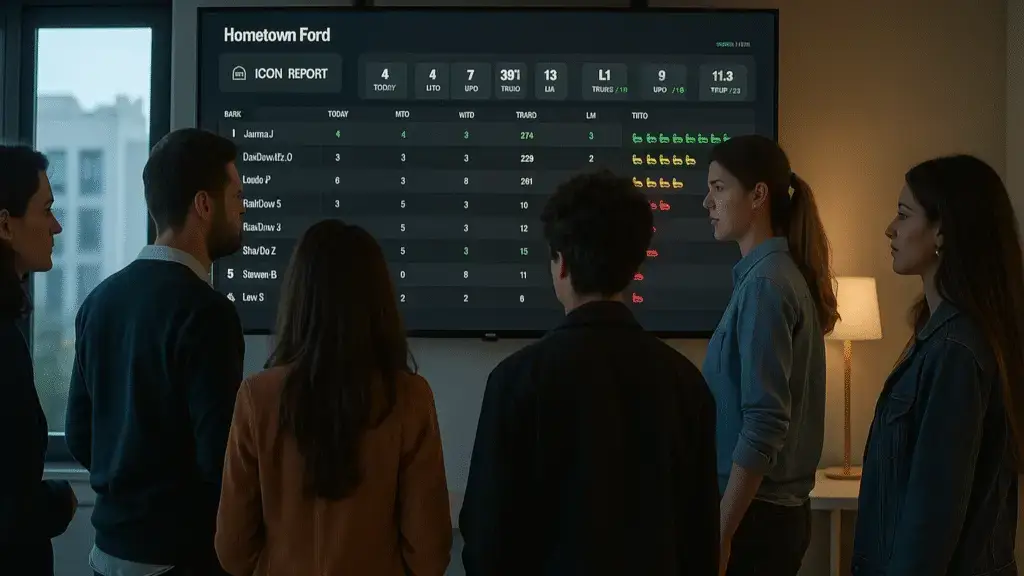Are you a car dealership looking to boost sales with higher efficiency? Studies show that employing a Business Development Center (BDC) can significantly enhance your reach and customer engagement.
This article will shed light on key performance indicators (KPIs) to track for optimizing your Dealership Sales BDC operations. So, are you ready to shift gears and drive toward improved business performance?
Key Takeaways
- Implementing a Business Development Center (BDC) can significantly enhance a car dealership’s reach and customer engagement.
- Key performance indicators (KPIs) to track for optimizing Dealership Sales BDC operations include outbound calls, texts, and emails; appointments set; total unit sales; and lead source management.
- Monitoring these KPIs can help dealerships improve their sales processes, measure the efficiency of their BDC and sales team, and make data-driven decisions to drive growth and profitability.
Understanding BDC in Car Dealerships

A Business Development Center, or BDC for short, is a crucial component of every car dealership. With its main calling to handle sales calls and keep the pipeline filled with potential opportunities, many dealerships often opt to use an external BDC.
The reason for this strategic move lies in the fact that salespeople typically don’t have sufficient time to make hundreds of needed calls each day.
To ensure effective customer engagement and conversion rate optimization, external BDC agents implement several follow-up attempts after their initial contact effort. On average, it takes 3.4 calls to connect with a lead successfully.
These diligent agents often go above and beyond by making six to eight attempts. Notably, leads having more than one phone number on record show higher contact rates, adding another layer of efficiency to the process.
Fulfilling different roles like setting service appointment settings or collecting survey data from customers post-visit can be part of the external BDC’s responsibilities as well, depending on how they are utilized within a Hybrid process model – combining internal dealership sales efforts with long-term follow-ups handled by an external BDC team.
Key Performance Indicators (KPIs) for Car Dealers Sales BDC
-for-Car-Dealers-Sales-BDC-4771eb1980-3870216172.jpg)
Effectively assessing how well your Sales BDC is doing involves carefully looking at various key performance indicators (KPIs) that are valuable benchmarks.
These include checking outbound calls, text messages, and emails to get a complete view of communication strategies. Also, looking at the number of appointments set helps understand how actively potential customers are engaged. Examining the total unit sales shows the actual outcomes of these efforts, highlighting the impact on overall sales performance.
A focused look at lead source management ensures that the origin and effectiveness of leads are handled strategically.
By using these KPIs for a thorough performance evaluation, you can gain a more complete and insightful understanding of how effective your Sales BDC is.
Outbound Calls, Texts, Emails

Outbound calls, texts, and emails are integral parts of car dealers’ sales BDC KPIs. These forms of communication serve as significant touchpoints between the dealership and the client.
| Outbound Calls | Texts | Emails |
|---|---|---|
| Outbound calls are an efficient way to reach out to leads. BDC agents make an average of 6 to 8 attempts and it usually takes 3.4 calls to connect with a customer. Roughly 45 to 50 percent of these calls generate an opportunity. | Text messaging is a preferred method of communication for many customers. It enables agents to maintain contact with potential clients while giving them the freedom to respond at their convenience. | Emails provide the opportunity to send detailed information and follow-up messages to potential clients. While they may not yield immediate responses, they remain an effective means of maintaining long-term contact with leads. |
| The length of the call can also be an indicator of customer engagement. Longer calls often suggest a better sales experience, whereas shorter calls are more common for setting service appointments. | BDC agents can use texts to send reminders for appointments and confirmations, enhancing the overall customer experience. | Emails are particularly useful for tracking purposes. They provide concrete evidence of communication between the dealership and the customer, and can be referred back to when needed. |
Outsourced BDC agents handling these outbound calls, texts, and emails can help elevate the performance of the dealership’s sales team.
They can focus on short-term follow-ups while the internal sales team manages the long-term ones, creating a hybrid process. The effectiveness of these methods is tracked by counting the number of units sold, which is used for reporting and commission.
Appointments Set

One of the critical KPIs for tracking Car Dealers Sales BDC performance is the number of appointments set. This refers to the number of confirmed engagements between potential buyers and the dealership sales team, set up by BDC agents.
| Parameter | Description |
|---|---|
| Number of Appointments Set | This reflects the count of secured appointments by the BDC for the sales team with prospective buyers. A higher number indicates effective engagement and conversion of leads into potential sales opportunities. |
| Appointments Conversion Rate | This is the percentage of appointments set by BDC agents that resulted in a successful sale. This KPI provides insight into the quality of appointments arranged by the BDC and the effectiveness of the sales team’s follow-up process. |
| Appointment No-Shows | This refers to the number of appointments set but not attended by the potential buyers. A lower number is preferable as it indicates efficient appointment management by the BDC and effective confirmation by the dealership. |
| Follow-up and Confirmation | Effective follow-up and confirmation are crucial for securing the appointments set by BDC agents. The dealership’s confirmation process plays a significant role in ensuring the scheduled appointments are attended by the potential buyers. |
Monitoring the appointments set and their conversion into actual sales helps measure the efficiency of the BDC and the sales team’s effectiveness in closing deals.
This KPI also aids in understanding the quality of leads generated, which can help in refining the lead generation and appointment setting processes.
Total Unit Sales

Total unit sales are a crucial Key Performance Indicator (KPI) that must be tracked by the Business Development Center (BDC) in car dealerships. This KPI is essential for tracking the BDC’s performance and is tied back to the BDC for both reporting and commission purposes.
An HTML table representation of the total unit sales KPI would be as follows:
Total Unit Sales Originated from BDC405560
| Month | Total Unit Sales |
|---|---|
| January | 100 |
| February | 120 |
| March | 130 |
This table provides a month-by-month breakdown of total unit sales and the portion of these sales that originated from the BDC’s efforts.
This allows for an accurate assessment of the BDC’s effectiveness in converting leads into showroom visitors and eventually into closed sales. It is the BDC’s responsibility to keep track and report on these figures. This data can inform strategic decisions, such as the reassessment of lead sources and market demographics when necessary.
Lead Source Management
 Lead source management is a crucial KPI that helps car dealerships understand where their leads are coming from and optimize their marketing strategies accordingly.
Lead source management is a crucial KPI that helps car dealerships understand where their leads are coming from and optimize their marketing strategies accordingly.
When effectively implemented, it can reveal the most profitable sources of leads and help direct marketing efforts for better return on investment.
| Lead Source | Number of Leads | Number of Conversions | Conversion Rate |
|---|---|---|---|
| Online Inquiry | 1500 | 100 | 7% |
| Email Campaign | 2000 | 120 | 6% |
| Direct Mail | 1000 | 50 | 5% |
| Social Media | 1800 | 150 | 8% |
| Referrals | 700 | 70 | 10% |
With proper lead source management, dealerships can easily identify which sources are driving the most business.
In the table above, social media and referrals seem to yield the highest conversion rates. It might be beneficial to focus a larger part of their marketing budget on these sources for increased returns. This kind of strategic decision-making becomes possible with efficient lead source management.
The Importance of Tracking BDC KPIs
![]()
Tracking BDC (Business Development Center) Key Performance Indicators (KPIs) is crucial for car dealerships to measure the success and effectiveness of their sales efforts. By monitoring these KPIs, dealerships can gain valuable insights into their sales processes and make data-driven decisions to improve performance.
One important KPI to track is the contact rate, which measures the percentage of leads that are successfully contacted by the BDC. This metric helps identify any gaps in lead management or communication strategies.
Tracking conversion rates allows dealerships to understand how effectively they are turning leads into appointments and, ultimately, sales. By analyzing this data, they can identify areas for improvement in their sales tactics and offer targeted training or coaching to their team.
Tracking metrics like outbound calls, texts, and emails can provide visibility into the level of activity and effort put forth by the BDC agents. This information enables managers to monitor individual agent performance as well as overall team productivity.
BDC KPIs provide dealership management with real-time insights into their business performance and empower them to make informed decisions that drive growth and profitability.
Conclusion – Tracking for Car Dealers

Key performance indicators (KPIs) for car dealer sales BDC is essential for measuring the success and effectiveness of your dealership’s sales efforts.
By monitoring metrics such as outbound calls, appointment sets, total unit sales, and lead source management, you can gain valuable insights into the performance of your BDC and identify areas for improvement.
Utilizing these KPIs will help optimize your dealership’s sales process, increase customer engagement, and ultimately drive higher sales numbers.
FAQs
1. What is BDC KPI tracking in the context of car dealerships?
BDC KPI tracking refers to monitoring and analyzing key performance indicators related to a dealership’s Business Development Center (BDC). This includes metrics such as lead conversion rates, appointment setting effectiveness, response time, and overall sales performance.
2. Why is it important for car dealerships to track BDC KPIs?
Tracking BDC KPIs allows car dealerships to measure the effectiveness of their sales team and identify areas for improvement. It provides insights into the efficiency of lead generation processes and customer engagement strategies and ultimately helps drive increased sales and revenue.
3. What are some common BDC KPIs that car dealerships should track?
Common BDC KPIs that car dealerships should track include lead response time (how quickly leads are contacted), appointment show rate (percentage of scheduled appointments attended), close ratio (percentage of leads converted into sales), and average deal size (average value of each sale).
4. How can car dealerships effectively track BDC KPIs?
Car dealerships can effectively track BDC KPIs by implementing a CRM system that allows them to capture and analyze data related to leads, appointments, and sales. They can also utilize reporting tools within their CRM or other software solutions to generate customized reports highlighting key metrics for analysis and decision-making purposes.




